
Mozambique, officially the Republic of Mozambique, is a country located in southeast Africa bordered by the Indian Ocean to the east, Tanzania to the north, Malawi and Zambia to the northwest, Zimbabwe to the west, and Eswatini and South Africa to the southwest. The sovereign state is separated from the Comoros, Mayotte and Madagascar by the Mozambique Channel to the east. The capital and largest city is Maputo.

Southern Africa is the southernmost region of Africa. No definition is agreed upon, but some groupings include the United Nations geoscheme, the intergovernmental Southern African Development Community, and the physical geography definition based on the physical characteristics of the land.

Mutare, formerly known as Umtali until 1982, is the most populous city in the province of Manicaland, and the third most populous in Zimbabwe, having surpassed Gweru in the 2012 census, with an urban population of 224,802 and approximately 260,567 in the surrounding districts, giving the wider metropolitan area a total population of over 500,000 people. Mutare is also the capital of Manicaland Province and the largest city in eastern Zimbabwe.

The Eastern Highlands, also known as the Manica Highlands, is a mountain range on the border of Zimbabwe and Mozambique. The Eastern Highlands extend north and south for about 300 kilometres (190 mi) through Zimbabwe's Manicaland Province and Mozambique's Manica Province.

Gonarezhou National Park is a national park located in southeastern Zimbabwe. It is situated in a relatively remote corner of Masvingo Province, south of Chimanimani along the Mozambique border. Owing to its vast size, rugged terrain and its location away from main tourist routes, large tracts of Gonarezhou remain pristine wilderness.

Brachystegia is a genus of tree of the subfamily Detarioideae that is native to tropical Africa.
The Ndau are an ethnic group which inhabits the areas in south-eastern Zimbabwe in the districts of Chipinge and Chimanimani in which they are natives. They are also found in parts of Bikita, in the Zambezi valley, in central Mozambique all the way to the coast and in central Malawi. The name "Ndau" means Land. Just like the Manyika people in northern Manicaland, their name Manyika also meaning "Owners of the Land", the name Ndau means Land. E.g "Ndau yedu" meaning "our land" When the Ngoni observed this, they called them the Ndau people, the name itself meaning the land, the place or the country in their language. Some suggestions are that the name is derived from the Nguni words "Amading'indawo" which means "those looking for a place" as this is what the Gaza Nguni called them and the name then evolved to Ndau. This is erroneous as the natives are described in detail to have already been occupying parts of Zimbabwe and Mozambique in 1500s by Joao dos Santos. The five largest Ndau groups are the Magova; the Mashanga; the Vatomboti, the Madanda and the Teve. Ancient Ndau People met with the Khoi/San during the first trade with the Arabs at Mapungumbwe and its attributed to the Kalanga people not Ndau. They traded with Arabs with “Mpalu” “Njeti” and “Vukotlo’’ these are the red, white and blue coloured cloths together with golden beads. Ndau people traded traditional herbs, spiritual powers, animal skins and bones.
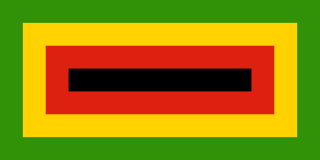
Zimbabwe African National Liberation Army (ZANLA) was the military wing of the Zimbabwe African National Union (ZANU), a militant African nationalist organisation that participated in the Rhodesian Bush War against white minority rule of Rhodesia.

Osteospermum moniliferum is an evergreen flowering shrub or small tree in the daisy family, Asteraceae. It is native to southern Africa, ranging through South Africa and Lesotho to Mozambique and Zimbabwe.

The banded martin or banded sand martin is a small passerine bird in the swallow family Hirundinidae that is endemic to Africa. It is the only species placed in the genus Neophedina.

The wildlife of Zimbabwe occurs foremost in remote or rugged terrain, in national parks and private wildlife ranches, in miombo woodlands and thorny acacia or kopje. The prominent wild fauna includes African buffalo, African bush elephant, black rhinoceros, southern giraffe, African leopard, lion, plains zebra, and several antelope species.

The grey go-away-bird, also known as grey lourie, grey loerie, or kwêvoël, is a bold and common bird of the southern Afrotropics. They are present in arid to moist, open woodlands and thorn savanna, especially near surface water. They regularly form groups and parties that forage in tree tops, or dust bathe on the ground. Especially when disturbed, they make their presence known by their characteristically loud and nasal "kweh" or "go-way" calls, with the last syllable typically a descending drawl. Within their range, their unique combination of colour, appearance and habits precludes confusion with other bird species.

The grey penduline tit, also known as the African penduline-tit, is a species of bird in the family Remizidae. It is found in Angola, Botswana, Burundi, Republic of the Congo, Democratic Republic of the Congo, Eswatini, Kenya, Malawi, Mozambique, Namibia, Rwanda, South Africa, Tanzania, Uganda, Zambia, and Zimbabwe. Its natural habitats are subtropical or tropical dry forests, dry savanna, and moist savanna. At 8 to 9 cm in length and a weight of 6.5 g (0.23 oz), it is one of the smallest species of bird found in Africa, along with its cousin the Cape penduline tit and the perhaps smaller mouse-colored penduline tit and the tit hylia.

The buffy pipit is a species of bird in the Motacillidae family. It is found in plains and open countryside in southern and eastern Africa. The IUCN has assessed its conservation status as being of least concern.
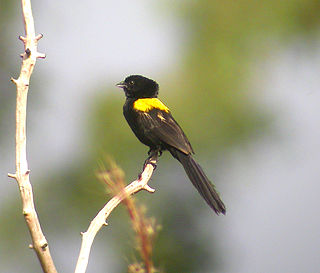
The yellow-mantled widowbird, also known as the yellow-backed widow, is a species of bird in the family Ploceidae.
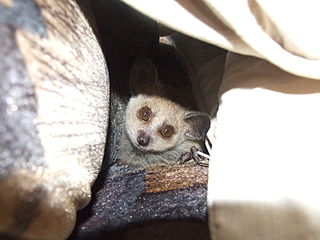
Grant's bushbaby, also known as Grant's lesser bushbaby or the Mozambique lesser bushbaby, is a species of primate in the family Galagidae. It is found in Malawi, Mozambique, Tanzania, and Zimbabwe. Its natural habitat is subtropical or tropical dry forests. It is a common species and the International Union for Conservation of Nature has assessed its conservation status as being of "least concern".

The Peters's epauletted fruit bat is a species of megabat in the family Pteropodidae. It is found in Angola, Botswana, Democratic Republic of the Congo, Eswatini, Malawi, Mozambique, Namibia, Tanzania, Zambia, and Zimbabwe. Its natural habitat is in riverine or evergreen forest, or moist woodland, where there are fruit-bearing trees.
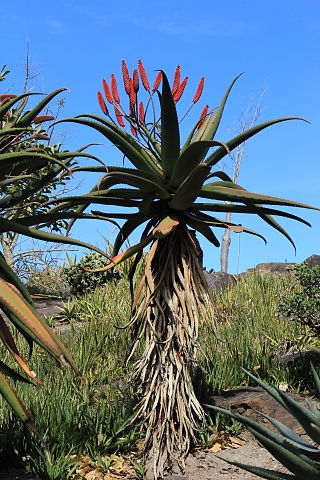
Aloe excelsa is an arborescent aloe indigenous to southern Africa.

Marshall's pygmy chameleon, also called Marshall's leaf chameleon, Marshall's dwarf chameleon, or Marshall's stumptail chameleon, is a species of chameleon found in the forests of Zimbabwe and Mozambique in Africa. It grows from 3.5 to 7.5 cm and feeds on insects. When standing still, it resembles a leaf on a branch.
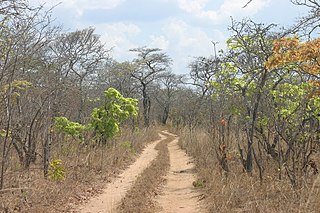
The Southern miombo woodlands is a tropical grasslands and woodlands ecoregion extending across portions of Malawi, Mozambique, Zambia, and Zimbabwe.



















